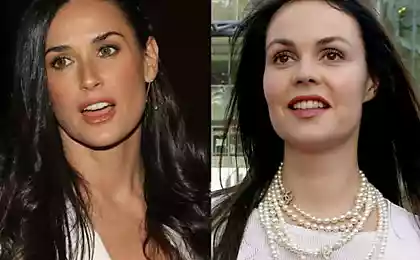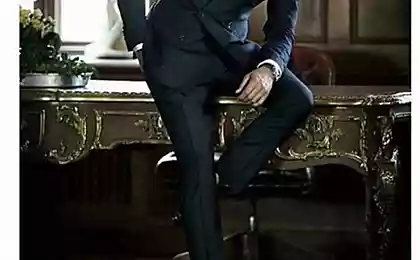1922
Secrets of realism
Very curious British artist to unravel the secret of incredible realism of Renaissance paintings.
Students of art schools and people interested in art history, you know that at the turn of the 14-15th centuries in painting took a dramatic turning point - the Renaissance. 1420's all of a sudden become much better draw. Why is the image suddenly become so realistic and detailed, as in the paintings of light appeared and volume? This was a long time no one thought. While David Hockney is not picked up a magnifying glass.
17 pictures.
via adme
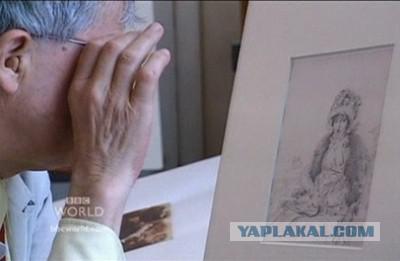
One day he looked at the drawings of Jean Auguste Dominique Ingres (Jean Auguste Dominique Ingres) - leader of the French academic school of the 19th century. Hockney was interesting to see his little drawings on a larger scale, and it increased them by Xerox. That's how he came across a secret side in the history of painting since the Renaissance.
Make copies of the small (about 30 centimeters) drawings by Ingres, Hockney was amazed at how realistic they are. And it seemed as if the line Ingres him something
resemble. It turned out that they remind him Warhol's work. A Warhol did so - projected photo on canvas and depicts him.

Interesting case, says Hockney. Apparently Ingres used the Camera Lucida - a device that is a structure with a prism, which is attached, for example, at the front to the tablet. Thus the artist, looking at his picture with one eye sees the real image, and the other - the actual figure and his hand. It turns an optical illusion, which allows for accurate transfer real proportion to the paper. And it is precisely the "pledge" realism.

Then Hockney was seriously interested in this "optical" view drawings and paintings. In his studio he and his team hung on the walls of hundreds of reproductions of paintings created over the centuries. Work that looked "real", and those that did not look. Located at the time of creation, and regions - north at the top, at the bottom of the south, Hockney with the team saw a sharp change in painting at the turn of 14-15 centuries. This is generally to everyone who knows a little bit about the history of art, it is known - Renaissance.
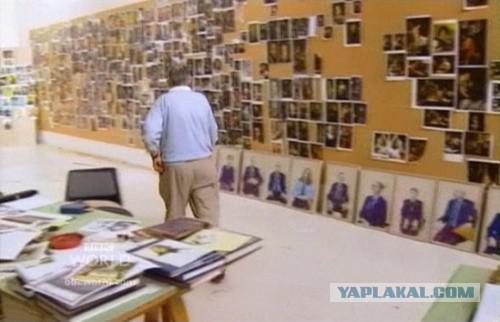
Maybe they used the very same camera lucida? It was patented in 1807 by William Hyde Wollaston. When in fact such a device is described by Johannes Kepler in 1611 still in his work Dioptrice. Then, perhaps, they used other optical devices - a pinhole camera? She had known since the days of Aristotle, and is a dark room, in which a small hole through the light falls and thus in a dark room turns projection of what is in front of the hole, but upside down. All anything, but the image that is obtained by the projection of a pinhole camera without a lens, to put it mildly, not quality, it is not clear, it requires a lot of bright light, not to mention the size of the projection. But the quality of the lens it was almost impossible to make up to the 16th century, because it does not exist at the time of ways to get such a high-quality glass. Cases, Hockney thought, by that time had the beat on the problem together with physicist Charles Falco.
However, there is a picture Jan Van Eyck, master of Bruges, Flemish painter of the early Renaissance, - in which the hidden clue. The picture is called "Arnolfini Portrait».

Painting just shines a huge amount of detail, which is quite interesting, because it was written only in 1434. And tips on how the author managed to make such a big step forward in realism, is a mirror. And candlestick - an incredibly complex and realistic
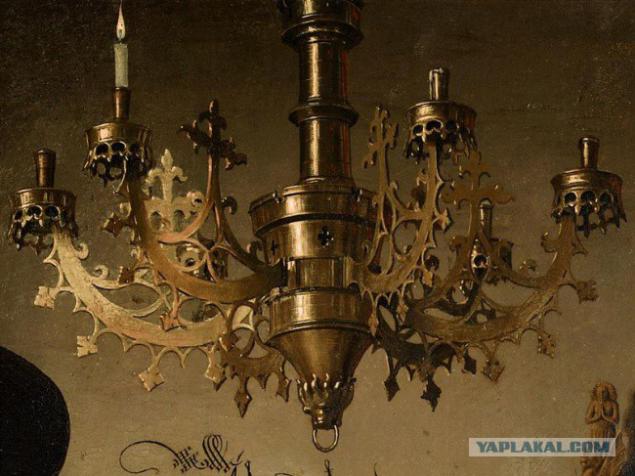
Hockney bursting with curiosity. He got hold of a copy of such chandeliers and tried to draw her. The artist was faced with the fact that such a complex piece difficult to draw in perspective. Another important point was the materiality of the image of the metal object. When the image is very important steel object positioned glare as much as possible really, since it attaches great realism. But the problem with these reflections is that they move when the viewer moves or artist that is not easy to capture them all. And realistic image of metal and glare - is also a distinctive feature of Renaissance paintings, before artists did not even try to do that.
Recreating the exact three-dimensional model chandeliers, Hockney team was convinced that the chandelier in the painting "Arnolfini Portrait" painted just one perspective vanishing point. But the problem was that such precision optical instruments, such as the camera obscura with a lens, there was still about a century after the creation of the painting.
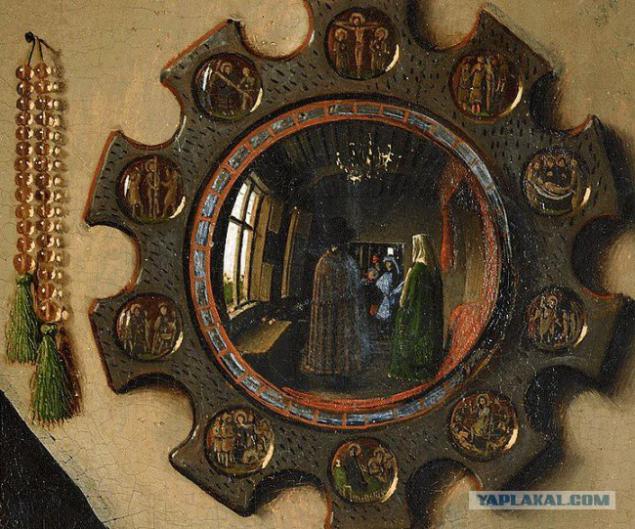
In the larger fragment can be seen that the mirror in the painting "Arnolfini Portrait" convex. And then there were the mirror opposite - concave. Even more so, in those days, such mirrors were made in such a way - was taken glass sphere and its bottom covered with silver, then all but the bottom cut off. The back side of the mirror is not obscured. Hence, the concave mirror Jan van Eyck could be the very mirror that depicted in the picture, just the reverse side. And any physicist knows what the reflection mirror image reflected projects. Here the calculations and research and helped his friend David Hockney physicist Charles Falco.

The size of a clear, focused projection of the approximately 30 square centimeters - and this is just the size of the heads on the set of portraits of the Renaissance
This is for example the size of the portrait "of the Doge Leonardo Loredan" authorship Giovanni Bellini (1501), Portrait of a Man authorship Robert Campin (1430), actually a portrait of Jan van Eyck's "man in a red turban" and yet many of the early Dutch portraits.
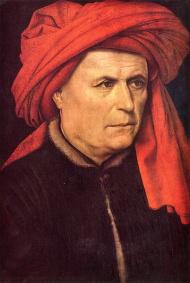
The painting was paid jobs, and of course, all business secrets kept in the strictest confidence. The artist was beneficial to all outsiders, people thought that the secrets in the hands of the master and shall not steal. The business was closed to outsiders - the artists were in the guild, it is composed very different masters - from those who have done the saddle to those who are doing the mirror. And in the Guild of St. Luke (Guild of Saint Luke), based in Antwerp, and was first mentioned in 1382 (then like guild opened in many northern cities, and was one of the largest guild in Bruges - the city where he lived Van Eyck) were also masters to make mirrors.
So Hockney has recreated the way in which you can draw complex chandelier with paintings by Van Eyck. It is not surprising that the size of the projected Hockney chandeliers coincides exactly with the size of the chandelier in the painting "Arnolfini Portrait". And of course the glare on metal - on the projection they stand still and do not change when the artist changes the position.
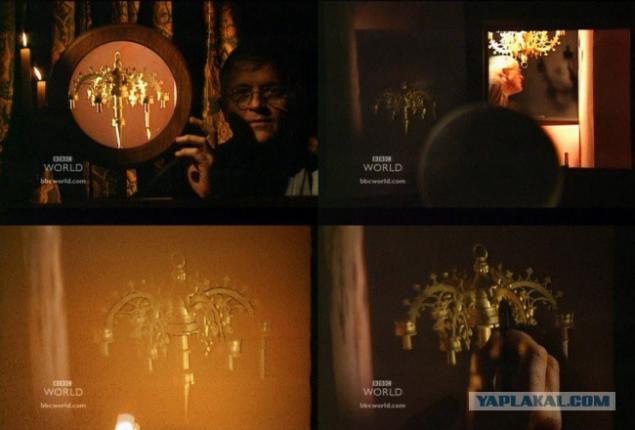
But the problem is still not solved completely, because before the advent of high-quality optics, which is necessary for the use of the camera obscura, was 100 years old, and the size of the projection obtained using a mirror, is very small. How to paint larger than 30 square centimeters? They were created as a collage - from a variety of points of view, as it turned out a spherical vision with lots of vanishing points. Hockney knew it because he was engaged in these pictures - he did a lot of photo-collages, which achieved the same effect.
After almost a century, in the 1500s it became possible to finally get a good handle and glass - there were large lens. And they can be finally inserted in the camera obscura, the principle of which has been known since ancient times. Pinhole camera with a lens was incredible revolution in visual art, because now the projection could be of any size. And one more thing: now the image was not "wide-angle", but about normal aspect - that is about for what it now at pictures with a lens with a focal length of 35-50mm.
However, the problem in the use of the camera obscura with a lens is that the direct projection of the mirror-lens. This led to a lot of left-handers in the painting in the early stages of using optics. As in this picture from the 1600s from the Frans Hals Museum, where the dancing couple left-handed, left-handed finger they face the old man, and a woman's dress looks left-handed monkey.
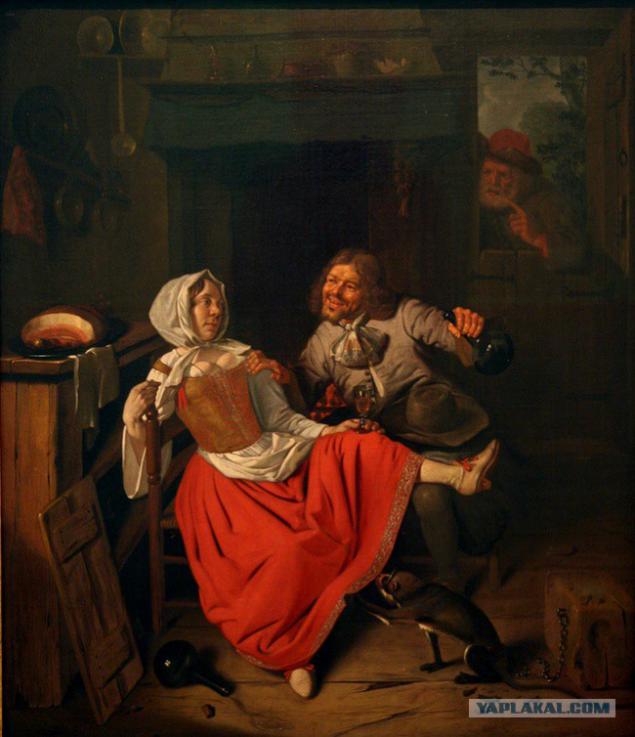
The problem is solved by setting a mirror in which the lens is focused, so get proper projection. But apparently, good smooth and large mirror was worth a lot of money, so that was not all.
Another problem has been in focus. The fact is that some parts of the picture at the same position of the canvas under the projection rays out of focus were not clear. On the work of Jan Vermeer, where it is clear you can see the use of optics, his work generally looks like a photograph, you can also notice no place in the "Focus". Even seen the picture that gives the lens - the notorious "bokeh". Just like here in the painting "The Milkmaid" (1658) basket of bread in it and a blue vase out of focus. But the human eye can not see "not in focus».
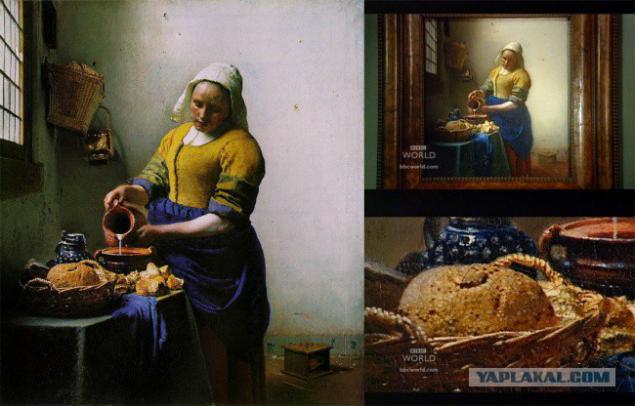
In light of this, it is not surprising that a good friend of Jan Vermeer was Anthony Phillips van Leeuwenhoek, a scientist and microbiologist, and a unique master, create your own microscopes and lenses. Scientist became the manager of a posthumous artist. This suggests that Vermeer painted it on his friend's two paintings - "Geography" and "Astronomer».
In order to see any part of the focus, it is necessary to change the position of the canvas under the rays of the projection. But in this case there is an error in the proportions. As can be seen here: huge shoulder "Antei" Parmigianino (about 1537), a small head "Lady Genovese" Anthony Van Dyck (1626), a huge peasant feet in the picture Georges de La Tour.
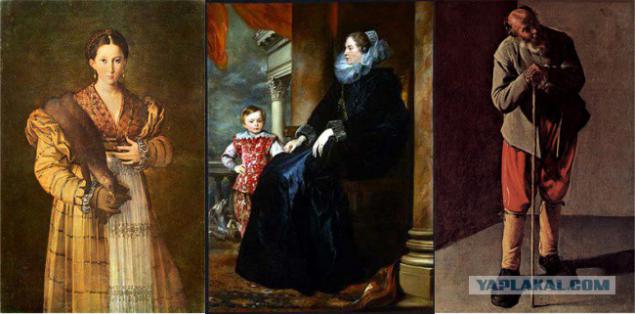
Of course, all the artists used lenses in different ways. Someone to outline someone was from different parts - now you can make a portrait, and the rest to finish with another model, or indeed with a dummy.
Almost no pictures and Velazquez. However, it remains his masterpiece - a portrait of Pope Innocent the 10th (1650). On the mantle of the pope - obviously silk - an incredible light. Glare. And to write all this with one point of view, it was necessary to try very much. But if you make a projection, all this beauty will not run away - glare no longer move, you can write precisely the broad and rapid brushstrokes like Velasquez.

Subsequently, the camera obscura could afford many artists, and it ceased to be a big secret. Canaletto has used the camera to create their own kinds of Venice and did not hide it. These pictures, due to its accuracy, allow us to speak about Canaletto as a documentarian. Thanks Canaletto can be seen not just a pretty picture, but history itself. You can see how was the first Westminster Bridge in London in 1746.
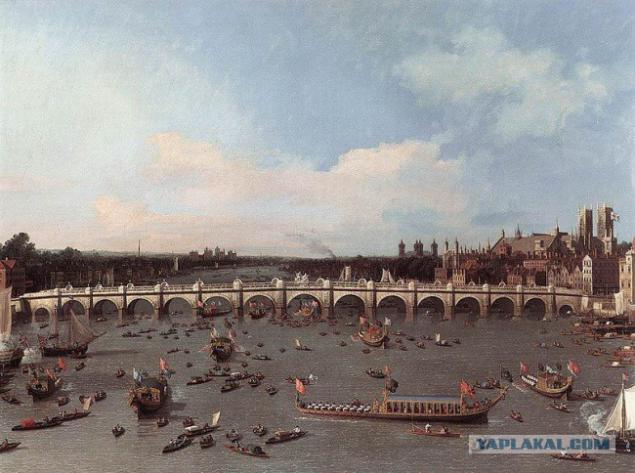
British artist Sir Joshua Reynolds owned the camera obscura and, obviously, no one talked about it, because it develops camera and looks like a book. Today, she is in the London Science Museum.
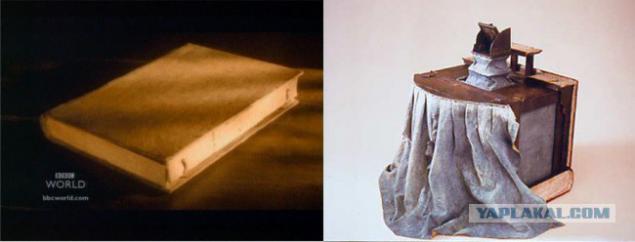
Finally, in the early 19th century by William Henry Fox Talbot, using camera lucida - the same one in which it is necessary to look with one eye and draw hands, swore, thinking that with such an inconvenience it is necessary to put an end once and for all, and became one of the inventors of chemical photography, and later popularized by making it mass.
With the invention of photography monopoly on painting realistic pictures gone, now the photo was a monopoly. And here at last freed painting from the lens by extending the path from which rolled in the 1400's, and Van Gogh became the forerunner of all the art of the 20th century.
Left: Byzantine mosaic 12th century. Right: Vincent van Gogh "Portrait of Mr. Trabuco" 1889
EVERYTHING.

Students of art schools and people interested in art history, you know that at the turn of the 14-15th centuries in painting took a dramatic turning point - the Renaissance. 1420's all of a sudden become much better draw. Why is the image suddenly become so realistic and detailed, as in the paintings of light appeared and volume? This was a long time no one thought. While David Hockney is not picked up a magnifying glass.
17 pictures.
via adme

One day he looked at the drawings of Jean Auguste Dominique Ingres (Jean Auguste Dominique Ingres) - leader of the French academic school of the 19th century. Hockney was interesting to see his little drawings on a larger scale, and it increased them by Xerox. That's how he came across a secret side in the history of painting since the Renaissance.
Make copies of the small (about 30 centimeters) drawings by Ingres, Hockney was amazed at how realistic they are. And it seemed as if the line Ingres him something
resemble. It turned out that they remind him Warhol's work. A Warhol did so - projected photo on canvas and depicts him.

Interesting case, says Hockney. Apparently Ingres used the Camera Lucida - a device that is a structure with a prism, which is attached, for example, at the front to the tablet. Thus the artist, looking at his picture with one eye sees the real image, and the other - the actual figure and his hand. It turns an optical illusion, which allows for accurate transfer real proportion to the paper. And it is precisely the "pledge" realism.

Then Hockney was seriously interested in this "optical" view drawings and paintings. In his studio he and his team hung on the walls of hundreds of reproductions of paintings created over the centuries. Work that looked "real", and those that did not look. Located at the time of creation, and regions - north at the top, at the bottom of the south, Hockney with the team saw a sharp change in painting at the turn of 14-15 centuries. This is generally to everyone who knows a little bit about the history of art, it is known - Renaissance.

Maybe they used the very same camera lucida? It was patented in 1807 by William Hyde Wollaston. When in fact such a device is described by Johannes Kepler in 1611 still in his work Dioptrice. Then, perhaps, they used other optical devices - a pinhole camera? She had known since the days of Aristotle, and is a dark room, in which a small hole through the light falls and thus in a dark room turns projection of what is in front of the hole, but upside down. All anything, but the image that is obtained by the projection of a pinhole camera without a lens, to put it mildly, not quality, it is not clear, it requires a lot of bright light, not to mention the size of the projection. But the quality of the lens it was almost impossible to make up to the 16th century, because it does not exist at the time of ways to get such a high-quality glass. Cases, Hockney thought, by that time had the beat on the problem together with physicist Charles Falco.
However, there is a picture Jan Van Eyck, master of Bruges, Flemish painter of the early Renaissance, - in which the hidden clue. The picture is called "Arnolfini Portrait».

Painting just shines a huge amount of detail, which is quite interesting, because it was written only in 1434. And tips on how the author managed to make such a big step forward in realism, is a mirror. And candlestick - an incredibly complex and realistic

Hockney bursting with curiosity. He got hold of a copy of such chandeliers and tried to draw her. The artist was faced with the fact that such a complex piece difficult to draw in perspective. Another important point was the materiality of the image of the metal object. When the image is very important steel object positioned glare as much as possible really, since it attaches great realism. But the problem with these reflections is that they move when the viewer moves or artist that is not easy to capture them all. And realistic image of metal and glare - is also a distinctive feature of Renaissance paintings, before artists did not even try to do that.
Recreating the exact three-dimensional model chandeliers, Hockney team was convinced that the chandelier in the painting "Arnolfini Portrait" painted just one perspective vanishing point. But the problem was that such precision optical instruments, such as the camera obscura with a lens, there was still about a century after the creation of the painting.

In the larger fragment can be seen that the mirror in the painting "Arnolfini Portrait" convex. And then there were the mirror opposite - concave. Even more so, in those days, such mirrors were made in such a way - was taken glass sphere and its bottom covered with silver, then all but the bottom cut off. The back side of the mirror is not obscured. Hence, the concave mirror Jan van Eyck could be the very mirror that depicted in the picture, just the reverse side. And any physicist knows what the reflection mirror image reflected projects. Here the calculations and research and helped his friend David Hockney physicist Charles Falco.

The size of a clear, focused projection of the approximately 30 square centimeters - and this is just the size of the heads on the set of portraits of the Renaissance
This is for example the size of the portrait "of the Doge Leonardo Loredan" authorship Giovanni Bellini (1501), Portrait of a Man authorship Robert Campin (1430), actually a portrait of Jan van Eyck's "man in a red turban" and yet many of the early Dutch portraits.

The painting was paid jobs, and of course, all business secrets kept in the strictest confidence. The artist was beneficial to all outsiders, people thought that the secrets in the hands of the master and shall not steal. The business was closed to outsiders - the artists were in the guild, it is composed very different masters - from those who have done the saddle to those who are doing the mirror. And in the Guild of St. Luke (Guild of Saint Luke), based in Antwerp, and was first mentioned in 1382 (then like guild opened in many northern cities, and was one of the largest guild in Bruges - the city where he lived Van Eyck) were also masters to make mirrors.
So Hockney has recreated the way in which you can draw complex chandelier with paintings by Van Eyck. It is not surprising that the size of the projected Hockney chandeliers coincides exactly with the size of the chandelier in the painting "Arnolfini Portrait". And of course the glare on metal - on the projection they stand still and do not change when the artist changes the position.

But the problem is still not solved completely, because before the advent of high-quality optics, which is necessary for the use of the camera obscura, was 100 years old, and the size of the projection obtained using a mirror, is very small. How to paint larger than 30 square centimeters? They were created as a collage - from a variety of points of view, as it turned out a spherical vision with lots of vanishing points. Hockney knew it because he was engaged in these pictures - he did a lot of photo-collages, which achieved the same effect.
After almost a century, in the 1500s it became possible to finally get a good handle and glass - there were large lens. And they can be finally inserted in the camera obscura, the principle of which has been known since ancient times. Pinhole camera with a lens was incredible revolution in visual art, because now the projection could be of any size. And one more thing: now the image was not "wide-angle", but about normal aspect - that is about for what it now at pictures with a lens with a focal length of 35-50mm.
However, the problem in the use of the camera obscura with a lens is that the direct projection of the mirror-lens. This led to a lot of left-handers in the painting in the early stages of using optics. As in this picture from the 1600s from the Frans Hals Museum, where the dancing couple left-handed, left-handed finger they face the old man, and a woman's dress looks left-handed monkey.

The problem is solved by setting a mirror in which the lens is focused, so get proper projection. But apparently, good smooth and large mirror was worth a lot of money, so that was not all.
Another problem has been in focus. The fact is that some parts of the picture at the same position of the canvas under the projection rays out of focus were not clear. On the work of Jan Vermeer, where it is clear you can see the use of optics, his work generally looks like a photograph, you can also notice no place in the "Focus". Even seen the picture that gives the lens - the notorious "bokeh". Just like here in the painting "The Milkmaid" (1658) basket of bread in it and a blue vase out of focus. But the human eye can not see "not in focus».

In light of this, it is not surprising that a good friend of Jan Vermeer was Anthony Phillips van Leeuwenhoek, a scientist and microbiologist, and a unique master, create your own microscopes and lenses. Scientist became the manager of a posthumous artist. This suggests that Vermeer painted it on his friend's two paintings - "Geography" and "Astronomer».
In order to see any part of the focus, it is necessary to change the position of the canvas under the rays of the projection. But in this case there is an error in the proportions. As can be seen here: huge shoulder "Antei" Parmigianino (about 1537), a small head "Lady Genovese" Anthony Van Dyck (1626), a huge peasant feet in the picture Georges de La Tour.

Of course, all the artists used lenses in different ways. Someone to outline someone was from different parts - now you can make a portrait, and the rest to finish with another model, or indeed with a dummy.
Almost no pictures and Velazquez. However, it remains his masterpiece - a portrait of Pope Innocent the 10th (1650). On the mantle of the pope - obviously silk - an incredible light. Glare. And to write all this with one point of view, it was necessary to try very much. But if you make a projection, all this beauty will not run away - glare no longer move, you can write precisely the broad and rapid brushstrokes like Velasquez.

Subsequently, the camera obscura could afford many artists, and it ceased to be a big secret. Canaletto has used the camera to create their own kinds of Venice and did not hide it. These pictures, due to its accuracy, allow us to speak about Canaletto as a documentarian. Thanks Canaletto can be seen not just a pretty picture, but history itself. You can see how was the first Westminster Bridge in London in 1746.

British artist Sir Joshua Reynolds owned the camera obscura and, obviously, no one talked about it, because it develops camera and looks like a book. Today, she is in the London Science Museum.

Finally, in the early 19th century by William Henry Fox Talbot, using camera lucida - the same one in which it is necessary to look with one eye and draw hands, swore, thinking that with such an inconvenience it is necessary to put an end once and for all, and became one of the inventors of chemical photography, and later popularized by making it mass.
With the invention of photography monopoly on painting realistic pictures gone, now the photo was a monopoly. And here at last freed painting from the lens by extending the path from which rolled in the 1400's, and Van Gogh became the forerunner of all the art of the 20th century.
Left: Byzantine mosaic 12th century. Right: Vincent van Gogh "Portrait of Mr. Trabuco" 1889
EVERYTHING.

